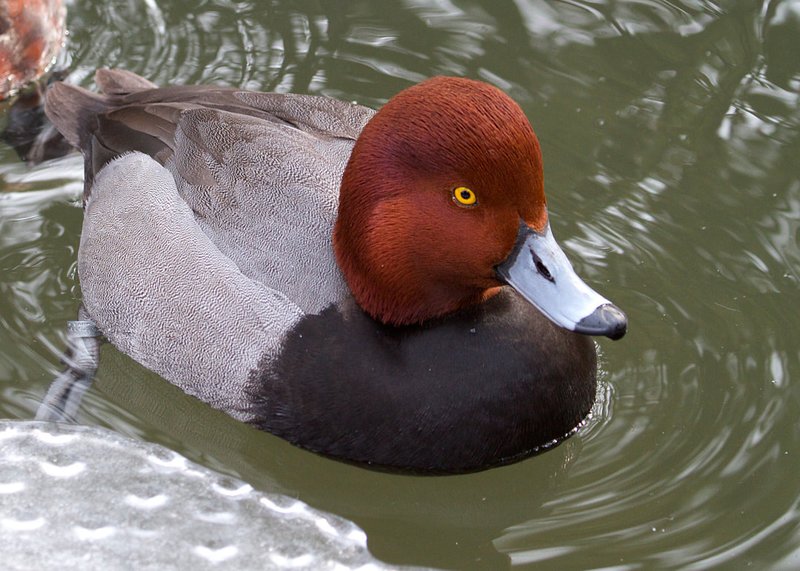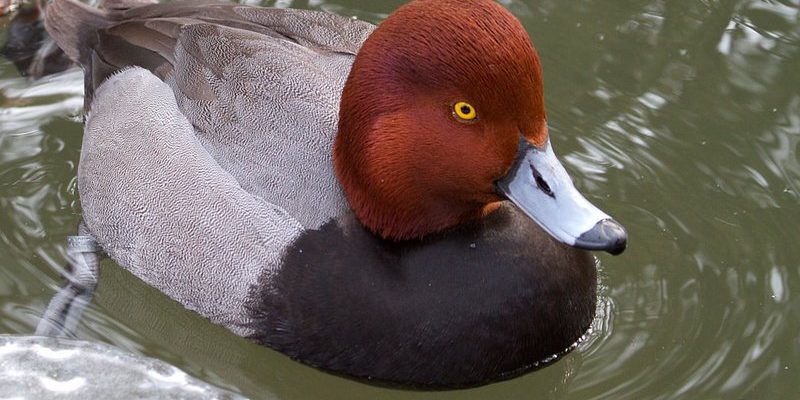
The Redhead Duck is one of those birds that can catch your eye and steal your heart. With its vibrant colors and unique appearance, it stands out among waterfowl. These ducks are often seen gliding gracefully across ponds and lakes, a sight that can evoke a sense of peace and joy. But there’s more to the Redhead Duck than just a pretty face. From its habitat and diet to its enchanting courtship displays, this bird has a lot to offer in terms of fascination.
You might be wondering why these ducks are called “Redhead.” Well, the males flaunt striking red heads that almost seem to glow against their grayish bodies. Females, while less colorful, possess a subtle beauty with their muted tones. As you observe these birds, you’ll start to appreciate the gentle nuances that make them special. Let’s dive deeper into the life of the Redhead Duck and uncover some intriguing facts!
Physical Characteristics of the Redhead Duck
The Redhead Duck is medium-sized, typically measuring around 14 to 20 inches in length. Males are usually larger than females and exhibit a distinctive red head and neck, paired with a gray body and black breast. The females, on the other hand, sport a more subdued color palette with a brownish-gray head and body, making them less conspicuous as a protective adaptation. Such differences in coloration during nesting season can optimize their chances of survival.
One of the standout features of the Redhead Duck is its striking, round head and sharp, pointed bill. This configuration is not just for looks; it plays a crucial role in their feeding behavior. With a diet primarily consisting of aquatic plants, seeds, and invertebrates, their bill is perfectly adapted for dabbling and foraging. The wingspan of these ducks is impressive too, averaging between 28 to 32 inches, which enables them to take flight quickly when threatened.
Another noteworthy aspect is their unique plumage, which changes with the seasons. Male Redhead Ducks sport a rich chestnut red head during the breeding season, but this can dull to a more muted tone outside of that period. The overall effect is both beautiful and practical, aligning with their mating rituals and seasonal behaviors.
Habitat and Distribution
Redhead Ducks are primarily found in North America, with a range that extends from southern Canada to central Mexico. They thrive in freshwater habitats, often choosing shallow lakes, ponds, and marshes as their preferred nesting grounds. These environments provide ample food resources and safe areas for raising their young.
During migration, Redhead Ducks can be spotted along various waterways, demonstrating a preference for larger, more open water bodies as they travel. In winter, they often congregate in coastal bays and estuaries, taking advantage of the rich food sources available in these habitats. This adaptability to different environments makes the Redhead Duck a resilient species, capable of thriving even in changing conditions.
The choice of habitat is closely linked to their diet. Redhead Ducks primarily feed on aquatic vegetation, including foods like pondweed, eelgrass, and various seeds. Understanding where they live is crucial to protecting these birds, ensuring they have access to the ecosystems they need to thrive.
Behavior and Social Structure
The social nature of the Redhead Duck is quite fascinating. They are generally seen in small groups, especially during the non-breeding season. This behavior gives them a sense of safety in numbers, which is vital for avoiding predators. You might witness them bobbing together on the water or diving to forage for food, an adorable sight that adds charm to their behavior.
When it comes to mating, male Redhead Ducks can put on quite the show. During courtship, they perform elaborate displays, including head-throwing and synchronized swimming, which serve to attract females. These displays often take place in open water and can be mesmerizing to watch. It’s a reminder that nature’s beauty often lies not just in the visual, but in the intricate behaviors that support life and love.
Communication is also key within these social structures. Redhead Ducks use a variety of vocalizations to convey information and establish relationships. Quacks, grunts, and whistles can often be heard among groups, especially during the mating season. Each sound serves a purpose, whether it’s attracting a mate or signaling a warning to others nearby.
Diet and Feeding Habits
Understanding the dining habits of the Redhead Duck can give you deeper insight into their role in the ecosystem. They are classified as dabbling ducks, meaning they feed primarily by tipping forward and reaching underwater for vegetation rather than diving extensively. This feeding method allows them to access plants like pondweeds and sedges, which constitute a significant portion of their diet.
In addition to plants, Redhead Ducks also consume invertebrates, such as small crustaceans and insects, especially during the breeding season when more protein is required. This varied diet aids in their overall health and reproductive success. As marshland and aquatic vegetation are essential for their feeding, the conservation of their habitats is critical for their survival.
Interestingly, their feeding habits also benefit the ecosystem. By consuming and dispersing seeds from aquatic plants, Redhead Ducks play a role in maintaining the health and balance of their habitats. This interconnection illustrates the importance of diverse species in sustaining healthy ecosystems.
Reproduction and Nesting
Reproduction in Redhead Ducks kicks into gear in the spring when males engage in courtship and territorial displays. Once paired up, females usually seek secluded areas to build their nests, often hidden among reeds or grasses near water bodies. The nests are lined with down feathers, providing warmth and protection for their eggs.
A typical clutch consists of 7 to 10 eggs, which the female incubates for about 25 to 30 days. This incubation period is a critical time, as the female must remain vigilant against predators. Once hatched, the ducklings are precocial, meaning they are relatively mature and can leave the nest shortly after birth. They instantly head towards water, where they learn to forage and swim almost immediately.
During the early stages, the mother duck is fiercely protective of her young, often leading them to safe spots where they can feed and grow. The bond between the mother and ducklings is strong, showcasing an incredible aspect of their behavior. Observing a mother Redhead Duck guiding her young is a heartwarming experience that many enthusiasts cherish.
Conservation Status of the Redhead Duck
The conservation status of the Redhead Duck is of concern in some areas. While the species is currently listed as “Least Concern” by the International Union for Conservation of Nature (IUCN), certain populations face threats due to habitat loss, mainly caused by wetland drainage and pollution. These changes disrupt their breeding and feeding habitats, making conservation efforts crucial.
Protecting wetland areas through conservation initiatives is vital for ensuring that Redhead Ducks have safe breeding and feeding grounds. Many wildlife organizations actively work on preserving these habitats, raising awareness, and promoting sustainable practices to benefit both the ducks and the ecosystem at large. Efforts include monitoring population trends and supporting habitat restoration projects.
Public engagement can also play a role in conservation efforts. Birdwatching and community education programs help raise awareness about the importance of these ducks and the ecosystems they inhabit. By fostering an appreciation for wildlife, we can inspire actions that protect these beautiful birds and their environments.
Fun Facts About Redhead Ducks
- A Group Name: A group of Redhead Ducks is called a “raft,” which captures their tendency to gather in groups on water.
- Migratory Patterns: Some Redhead Ducks migrate over 1,000 miles between breeding and wintering grounds.
- Unique Adaptation: They can dive to depths of about 6 feet to find food, but they prefer to stay in shallower waters.
- Vocalizations: Male Redhead Ducks have distinct quacking sounds that are different from those of females.
- Longevity: In the wild, Redhead Ducks can live up to 10 years, but challenges like predation and habitat loss can impact their lifespan.
FAQ
What is the diet of a Redhead Duck?
The Redhead Duck primarily feeds on aquatic plants like eelgrass and pondweed, as well as various seeds and invertebrates. They often forage by dabbling, tipping forward to reach underwater vegetation. During breeding season, they may consume more protein-rich foods, including small crustaceans and insects to support their young. Access to clean, healthy water bodies is crucial for their diet.
Where do Redhead Ducks nest?
Redhead Ducks typically build their nests in marshy areas, hidden among reeds or dense vegetation near water bodies. These locations offer protection from predators while providing easy access to food. The female tends to select secluded spots, often placing her nest on the ground, lined with down feathers for warmth and comfort.
How can I identify a male Redhead Duck?
Males are easily recognized by their distinctive reddish-brown heads, black chests, and gray bodies. In contrast, females are mottled brown and less colorful but have a more subtle beauty. During the breeding season, males display courtship behaviors, including head-throwing and showing off their plumage, making it easier to identify them.
Are Redhead Ducks migratory?
Yes, Redhead Ducks are migratory birds. They travel from their breeding grounds in Canada and northern climates to wintering areas in the southern U.S. and Mexico. Migration usually occurs in the fall, and they often congregate in larger groups during their travels. Their migratory patterns can cover significant distances, sometimes exceeding 1,000 miles.
What threats do Redhead Ducks face?
While currently classified as “Least Concern,” Redhead Ducks face threats from habitat loss due to wetland drainage, pollution, and climate change. These factors can disrupt their nesting and feeding grounds, significantly impacting their populations. Conservation efforts are focused on protecting their habitats and promoting sustainable practices to ensure their survival.
How can I help protect Redhead Ducks?
You can contribute to the protection of Redhead Ducks by supporting local conservation efforts focused on wetland preservation. Participating in birdwatching and educational programs can help raise awareness of these beautiful birds. Additionally, advocating for clean water initiatives and responsible land use can make a difference in maintaining healthy ecosystems for the ducks and their habitats.
What are the vocalizations of Redhead Ducks like?
Redhead Ducks have a range of vocalizations that include quacks, grunts, and whistles. Males tend to have more distinctive quacking sounds, which they use during courtship and to communicate with other ducks. These vocalizations not only play a role in attracting mates but also in establishing territory and signaling danger.
How long do Redhead Ducks live?
In the wild, the average lifespan of a Redhead Duck can reach up to 10 years. However, their lives can be cut short due to predation, habitat loss, and environmental hazards. Steps to conserve their habitats and protect them from threats are vital to improving their longevity and overall population health.
Can Redhead Ducks dive underwater?
While Redhead Ducks are primarily dabbling ducks, they can dive underwater to a depth of about 6 feet in search of food. However, they prefer to feed in shallower waters where they can easily reach aquatic plants and seeds without diving extensively. Their feeding habits are adapted to their surroundings and the availability of food sources.

